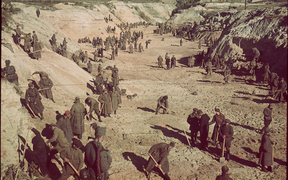 This month marks the 80th anniversary of the worst of the Nazis’ multitude of atrocities on Ukrainian soil, the massacre at Babi Yar on 29-30 September 1941, which began on the eve of Yom Kippur. The Babi Yar tragedy was largest open-air massacre during the so-called Holocaust by Bullets, when 33,771 people – according to meticulous record-keeping by the SS – mostly women, children and the elderly, were shot. In the months that followed, tens of thousands more people were murdered at Babi Yar, the overwhelming majority Jews, but also Roma, Ukrainian nationalists and Soviet prisoners of war. The killing came to a halt in 1943, with the Germans in retreat from the Soviet territory they had occupied. Berlin ordered that mass execution sites be excavated so the corpses could be burned, fearing that the Soviet Union would use them as evidence for propaganda purposes. Until its collapse in the 1990s, the Soviet Union suppressed memory of the Jewish genocide that had taken place on its soil. National policy was to erase differences among the victims of Nazism. This included ‘erasing’ the ravine itself by filling it with industrial waste and making way for what exists at the site today – a wide street lined on one side with apartment blocks, and a grassy park on the other, where children play and lovers meet. “Babi Yar is a symbol of the Soviet Union’s efforts to physically erase memory. They took the most tragic part of our history and tried to make it disappear. Thanks to an independent Ukraine, the policy was fully changed towards the memory of the Holocaust,” human rights activist and chairman of the Babi Yar Holocaust Memorial Center, Natan Sharansky, said last year at a ceremony to mark the anniversary of the massacre. The Memorial Center, established in 2016 to build a major new Holocaust museum in Kiev, is due to open its doors in 2026 but has already been the subject of considerable controversy. The disagreements stem largely from the appointment of the contentious Russian filmmaker Ilya Khrzhanovsky as artistic director and his plans for a virtual reality installation, deemed inappropriate by many and dubbed a “Holocaust Disneyland” by one former curator when he quit the project. Objections have also been raised about the role of some of the Center’s Russian Jewish billionaire funders and its location in the grounds of an old Jewish cemetery. But a number of research projects developed by the Center have yielded fascinating results. Last year a 3D model of the massacre site was created, led by former Scotland Yard investigator Martin Dean, who specialises in Nazi war crimes. By combining ground and aerial photography, maps, historical reports and witness testimonies, Dean was able to build an overall picture of a mass grave about 150 metres long, in which corpses were stacked in layers like sardines, and to pinpoint for the first time in three-quarters of a century exactly where it was located. Another recent research initiative is the Names Project, which has uncovered the identities of more than 900 of the victims of Babi Yar, whose fates had previously been unknown. Estimates of the total death toll at Babi Yar in 1941-43 range from 70,000 to 100,000. Apart from details of the September massacre, records of those killed were sporadic. The Names Project is attempting to collect data on all those murdered at Babi Yar and the researchers hope eventually to have a web page for each identified victim, complete with details of their life story and a picture. In partnership with the Memorial Center, Ukrainian director Sergei Loznitsa released a film this year to coincide with the 80th anniversary. Babi Yar.Context – a series of short documentaries – premiered at the Cannes Film Festival in July. Loznitsa was born close to Babi Yar but grew up in ignorance of what had happened there. His film is based on archival material using footage from the period, including newsreels, court trials and amateur films by German soldiers. It begins with Germany’s invasion of Ukraine in 1941 and concludes in March 1961 with the little-known Kurenivka mudslide – a disaster that resulted from the Soviet authorities’ attempts to erase memory of Babi Yar by filling the ravine with industrial waste. A decade later, heavy rain caused a dam securing a brick pulp dump to collapse, triggering a mudslide that released up to four metres of mud, water and human remains onto the streets. A recent report estimates that 1,500 people may have died as a result.
0 Comments
Leave a Reply. |
Keeping stories aliveThis blog aims to discuss historical events relating to the Jewish communities of Ukraine, and of Eastern Europe more widely. As a storyteller, I hope to keep alive stories of the past and remember those who told or experienced them. Like so many others, I am deeply troubled by the war in Ukraine and for the foreseeable future, most articles published here will focus on the war, with an emphasis on parallels with other tumultuous periods in Ukraine's tragic history. Archives
March 2024
Categories
All
|
 RSS Feed
RSS Feed
